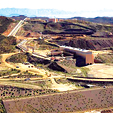Legislation & Regulation
Legislative and Regulatory Update
September 2013 by Scott Harn
• Comment period extended for frog habitatThe US Fish & Wildlife Service continues to recommend restrictions on public lands under the guise of critical habitat for endangered and threatened species. One of their more recent, larger efforts, has been to withdraw two million acres in California and parts of Nevada for the Yellow Legged Frog and Yosemite Toad.
A settlement agreement between Fish & Wildlife, the Center for Biological Diversity and other groups in Center for Biological Diversity v. Salazar (10-cv-0230) in July 2011 is the driving force behind the push for critical habitat. An additional settlement was reached in April 2013, and like the first one, the agreement was made behind closed doors and without public input.
Radical environmental groups were seeking to have several hundred species designated as endangered and the establishment of critical habitat for each species. Despite a recent 9th Circuit Court ruling which declared “sue and settle” agreements illegal, Fish & Wildlife has continued down this destructive path.
The agency has cited pesticides and the introduction of non-native trout as the biggest threats to the two species of frog, yet their knee-jerk response to fixing the problem is to place more public lands off-limits.
Western Mining Alliance, in conjunction with Defend Rural America, sent information packets and fact sheets to the Senate and House Natural Resources Committees to ask for their assistance in stopping these illegal back-room deals, which got the attention of several Senators.
The Senate Committee responded with a letter demanding details of the settlement agreement, which stated, “Many of the more than 250 listings that could occur as a result of these settlements will have a tremendous impact on states and local governments, private property rights, and economic growth. Yet, FWS chose to make these agreements with two litigious environmental groups without any consultation from Congress or affected stakeholders.
“For the third time, we request that you provide us with... the information related to the... settlement.”
Congressman Tom McClintock (R-CA), testified before Congress, “The designation would add draconian new restrictions to those that have already severely reduced productive uses such as grazing, timber harvesting, mining and recreation… The species that will be most affected by this action is the human population, and that result will be tragic, severe, and entirely preventable.”
Due to the efforts of the Western Mining Alliance, Defend Rural America, and concerned Senators, the comment period for the proposed critical habitat has been extended to November 18, 2013.
The proposed critical habitat rule can be viewed and comments can be submitted at www.regulations.gov
Enter “yellow frog” in the search window to bring up a link to the proposed rule.
• Tennessee permits for gold prospecting
The Tennessee Department of Environment and Conservation (TDEC) is drafting regulations for gold prospecting in the state’s waterways.
Tennessee’s Tellico River and Coker Creek have long been popular with gold prospectors, with panning, highbanking and dredging being the most popular techniques employed. While gold is not as abundant as you might find in other states, it’s not that difficult to make decent wages at current gold prices.
Unfortunately, a couple of prospectors and swimmers got into a heated argument over use of a particular area in 2012, said David McKinney of the Tennessee Wildlife Resources Agency, and complaints from the swimmers brought the lack of regulations to the attention of the agencies.
As a result, TDEC is currently working on regulations and a permitting process for small-scale mining in state waterways.
This case is a good reminder to be on your best behavior when out prospecting—a couple of bad apples can cause a lot of damage to the image of all miners and prospectors. We’ll keep you posted.
• California dredging injunction and restraining order hearing
The request for a injunction and temporary restraining order to restore the rights of suction gold dredgers in California is scheduled for August 27, 2013, at Rancho Cucamonga Superior Court in San Bernardino County, California.
The case has implications for all the Western states where suction gold dredging occurs. Regulatory agencies and dredgers in Washington, Oregon and Idaho all have a vested interest, and there is no doubt that regulatory officials in each of these states will be watching to see if the miners are successful. We are hoping and praying that suction dredge miners will be back in the water shortly.
The hearing is after our press deadline, so check our website at www.icmj.com for the latest news.

Legislative and Regulatory Update
• Positive bill passes House
• Anti-mining bill dies in Washington State
It's Time to Get the Heck Out of China
 We are at a crossroads; either we establish the mining, production and refining of rare earth elements here in the US or we remain subjected to the whims of the Chinese government.
We are at a crossroads; either we establish the mining, production and refining of rare earth elements here in the US or we remain subjected to the whims of the Chinese government.
PLP Update: Another Suction Dredge Case Heading to the US Supreme Court
 In the meantime, we will continue our multi-pronged approach to seek regulatory relief at the federal level while supporting those court cases that are built on a strong legal foundation.
In the meantime, we will continue our multi-pronged approach to seek regulatory relief at the federal level while supporting those court cases that are built on a strong legal foundation.
EPA Reopens Comments on Pebble Project
The settlement did not grant an immediate approval for the project, but it did begin to clear the way for the company to apply for federal permits—a path the Obama administration previously had thwarted.
MMAC & PLP Update -- 2015 Minerals and Mining Regulatory Reform Act
Is there any hope for a solution? Yes, there is, and we’ve been working with Public Lands for the People, the Minerals and Mining Advisory Council, attorney James Buchal and others on that solution.
Miners Fight Back When BLM Says 'Your Claim Is Too Long'
BLM stated we had 30 days to amend our claim so that it fit within one 40-acre square or we would forfeit the claim.
Mining Districts: A Short Review of Legal Authorities
Mining Districts are the private regulatory authority granted by Congress recognized to regulate the mineral lands held by the United States and for the disposal to citizens of the United States, by means of development and potentially perfected by patent.
Subscription Required:
The Bawl Mill
• Ask the Experts
• Ask the Experts
• Ask the Experts
• Greenstone and Gold
• The Long Road to Gold Point, Nevada
• What, Where and How for the New Prospector
• Proper Spacing of Placer Sample Sites
• Hunches, Choices and Guesses
• 12-Year-Old Unearths Large Diamond
• Time for a New Approach: Detecting Float Gold
• Carissa Gold Mine Comes Back to Life
• Gold in Beatty, Nevada
• Cripple Creek Gold Mine Exceeding Expectations
• Melman on Gold & Silver
• Mining Stock Quotes and Mineral & Metal Prices
Free:
Silver Bull Resources Sees Bright Future for Silver & Zinc
• Twenty Minutes on a Five-inch Dredge








